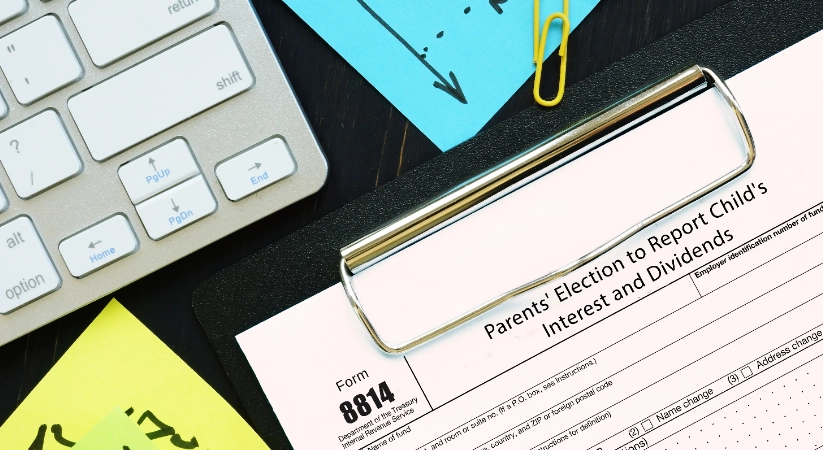
Are you the parent of a full-time student and unsure of your tax filing requirements? Form 8814, Parent’s Election to Report Child’s Interest and Dividends, is a helpful tool that can assist you in making sure you are compliant with all applicable IRS regulations. In this article, we’ll explore the terms and concepts of Form 8814, filing requirements for joint returns involving full-time students, capital gain distributions, unearned income considerations, dividend income considerations for separate returns and more. So let’s get started!
About Form 8814: Reporting a Child’s Interest and Dividends
Form 8814, Parent’s Election to Report Child’s Interest and Dividends, is an IRS form used by parents of full-time students with investment income to report that income on their own returns. This form allows parents to include their child’s income in their own return and avoid the need for the student to file a separate return.
Parents must report any interest and dividend income from private activity bonds and qualified dividends as well as any annuity income or capital gain distributions. They must also calculate the taxable amount of unearned income in excess of $2,100, taking into account itemized deductions or standard deduction applied to the source of this income.
It is important for parents to note that Form 8814 does not cover all types of income. For instance, any taxable income in excess of $2,100 received from sources other than investments and certain tax-exempt interest must be reported on a separate tax return for the child. Additionally, any earned income (such as wages) must also be reported on a separate return regardless of the amount earned.
Parents should also remember that completing this form can help minimize taxes owed but any errors made while filling out the form could result in additional taxes due so it is important to double check all information before submitting it.
What are the differences between Form 8814 and Form 8615?
Form 8814 and Form 8615 are both forms used by parents when filing a joint return with their child’s investment income. Form 8814 allows parents to report the child’s unearned income, such as dividends and capital gains, on their own tax returns. On the other hand, Form 8615 is used to calculate the tax owed on the child’s investment income and to report that tax on their tax return.
It is important to note that all rules regarding filing requirements for full-time students should be verified with a tax professional before submitting your taxes in order to ensure your accuracy and minimize taxes owed.
Itemizing Deductions on Form 8814
Itemizing deductions on Form 8814 can be a great way for parents of full-time students to reduce the overall tax burden on their returns. When filing taxes, parents must report any investment income exceeding $1,200 on Form 8814. By itemizing deductions on this form, parents can claim certain expenses they have paid throughout the year as a deduction against their taxable income. This can include tuition, student loan interest payments and other educational related expenses. Additionally, parents may also be able to deduct any state or local taxes they have paid during the year, as well as certain miscellaneous items such as job related expenses or charitable contributions.
IRS Requirements For Children With Investment Income Over $2,100
When a child has investment income over $2,100 in a year, the Internal Revenue Service (IRS) requires that the parent or guardian of the child file Form 8814. This form is used to report the child’s dividend income, capital gain distributions, qualified dividends and private activity bond interest. In addition to filing Form 8814, parents also need to make estimated payments on behalf of their children if they owe any tax liability due to their unearned income. For example, if your child receives annuity income or other types of unearned income exceeding $2,200 then they may be required to file a separate tax return from yours.
Children with unearned income may be subject to different rules and regulations when it comes to taxation. The IRS requires that parents of a child under the age of 19 (or 24 for full-time students) who have investment income in excess of $2,200 must file a separate tax return using Form 8814. This form is used to report dividends, capital gain distributions, and other types of investment income. Furthermore, the child cannot claim any itemized deductions or the standard deduction on their separate tax return; instead, all items must be reported as income.
Additionally, any dividend income attributable to the child will be taxed at the parent’s marginal rate regardless of whether or not the parent claims it on their own returns. Finally, any taxable income earned by the child over $12,400 will be taxed at their own rate rather than at their parent’s rate.
Understanding these rules can help ensure taxes are paid correctly and in full while avoiding potential penalties or interest due to underpayment.
Taxpayers can use Form 8814 to report dividends and other types of unearned income when filing a separate return. Whether to itemize or take the standard deduction is another important consideration for calculating tax liability from dividend income and long-term capital gains.

Nick Charveron
Nick Charveron is a licensed tax practitioner and Partner & Co-Founder of Community Tax, LLC. As an Enrolled Agent, the highest tax credential issued by the U.S. Department of Treasury, Nick has unrestricted practice rights before the IRS. He earned his Bachelor of Science from Southern Illinois University while serving with the U.S. Army Illinois National Guard and interning at the U.S. Embassy in Warsaw, Poland. Based in Chicago, Nick combines his passion for finance and real estate with expertise in tax and accounting to help clients navigate complex financial challenges.







